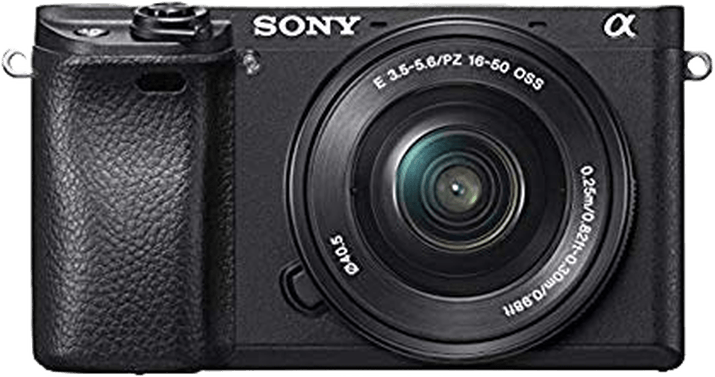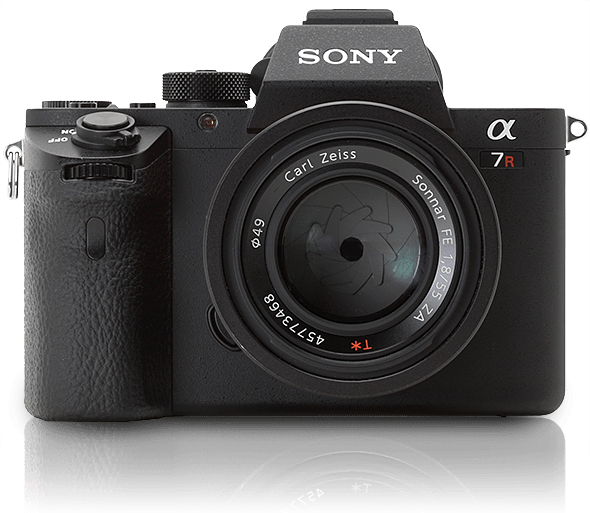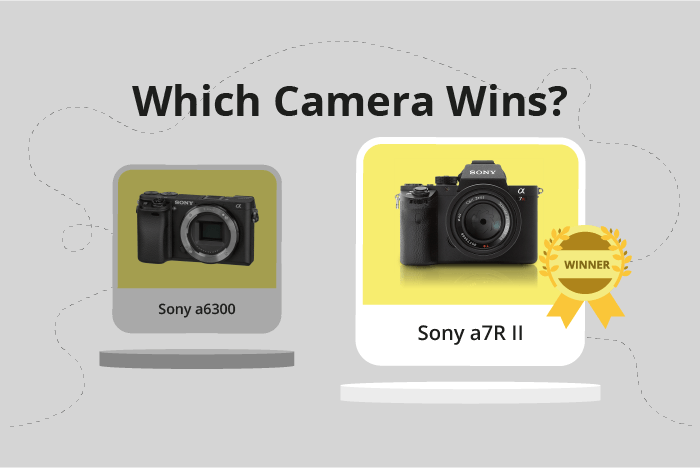Sony a6300 vs a7R II Comparison
Sony a6300

Sony a7R II

The Sony a7R II outperforms the Sony a6300 with a score of 70/100 compared to the latter’s 61/100. Both cameras are mirrorless and were released in 2015 and 2016, respectively. The a7R II has a higher launch price of $3198, while the a6300 was introduced at $1000.
The two cameras share similarities in their design, with the a7R II measuring 127 x 96 x 60mm and the a6300 at 120 x 67 x 49mm. The a7R II is heavier, weighing 625g, while the a6300 is lighter at 404g.
The Sony a7R II’s higher score indicates its superior performance and features. However, the Sony a6300 offers a more affordable option for those on a budget without compromising on quality. Both cameras provide excellent results, and the choice ultimately depends on the user’s preferences and requirements.
Sony a6300 vs a7R II Overview and Optics
The Sony a7R II takes the lead in optics with a score of 81/100, outperforming the Sony a6300 which has a score of 68/100. Both cameras share several specifications including a CMOS sensor, Bionz X processor, and compatibility with Sony lenses. The a7R II, however, boasts superior features that contribute to its higher score.
The a7R II’s advantages include a higher megapixel count of 42.4, compared to the a6300’s 24.2, allowing for more detailed images. Additionally, the a7R II has a full-frame sensor, which is larger than the a6300’s APS-C sensor. The larger sensor size results in better low-light performance, dynamic range, and depth of field control. The a7R II also has a higher DXOMARK sensor score of 98, indicating better overall image quality. Furthermore, the a7R II is equipped with image stabilization, which the a6300 lacks, providing steadier shots in various shooting conditions.
On the other hand, the Sony a6300 has a faster shooting speed of 11 frames per second (fps) compared to the a7R II’s 5 fps. This makes the a6300 more suitable for capturing fast-moving subjects, such as sports or wildlife photography.
Considering these factors, the Sony a7R II is the better option for photographers who prioritize image quality, low-light performance, and image stabilization. The Sony a6300, though not as strong in these areas, is still a solid choice for those who require faster shooting speeds.
Sony a6300 vs a7R II Video Performance
The Sony a6300 outperforms the Sony a7R II in video capabilities, with a score of 91/100 compared to the a7R II’s 56/100. Both cameras share some common video specifications, such as a maximum video resolution of 4K and maximum video dimensions of 3840 x 2160. However, there are significant differences that make the a6300 a better choice for videographers.
The a6300 has a higher maximum video frame rate of 120fps, while the a7R II is limited to 30fps. This means the a6300 can capture smoother, more detailed slow-motion footage, providing greater creative flexibility in post-production. Additionally, the a6300 has built-in time-lapse functionality, which allows users to create stunning time-lapse videos without the need for additional equipment or software.
On the other hand, the a7R II’s video capabilities are not without merit. Despite its lower score, the a7R II still offers 4K video resolution and the same maximum video dimensions as the a6300. This means that the a7R II can still produce high-quality video footage, even if it may not offer the same level of versatility as the a6300.
Considering these factors, the Sony a6300 is the superior choice for videographers due to its higher maximum video frame rate and built-in time-lapse functionality. The a7R II, while still capable of producing high-quality video, falls short in comparison to the a6300’s advanced features and versatility.
Sony a6300 vs a7R II Features and Benefits
The Sony a7R II wins the features comparison with a score of 57/100, while the Sony a6300 scores 54/100. Both cameras share several specifications, such as a 3-inch screen, flip screen, WiFi connectivity, and lack of GPS and Bluetooth.
The Sony a7R II outperforms the a6300 with a higher screen resolution of 1,228,800 dots, compared to the a6300’s 921,600 dots. This means the a7R II provides a clearer and more detailed view of the images on its screen.
On the other hand, the Sony a6300 does not have any advantages over the a7R II in terms of features. Both cameras have the same screen size, flip screen, WiFi connectivity, and lack of GPS and Bluetooth. The only difference is the screen resolution, where the a7R II is superior.
Considering these points, the Sony a7R II is the better choice in terms of features, offering a higher screen resolution for a more detailed view of the images. The Sony a6300 does not provide any additional features that make it a better option when comparing the two cameras.
Sony a6300 vs a7R II Storage and Battery
The Sony a6300 triumphs over the Sony a7R II in the storage and battery category, scoring 24 points compared to the a7R II’s 16 points. Both cameras have one memory card slot and accept SD, SDHC, and SDXC memory cards. Additionally, they both use the NP-FW50 battery type and do not support USB charging.
The a6300 excels with a longer battery life, providing 400 shots per charge, while the a7R II only offers 290 shots. This extended battery life makes the a6300 more reliable and convenient for extended shooting sessions.
On the other hand, the a7R II has the advantage of accepting Memory Stick Duo, Pro Duo, and Pro-HG Duo cards in addition to the SD card types. This flexibility might be beneficial for users who already have these card types or prefer them.
Considering these factors, the Sony a6300 provides a superior battery life, making it a more reliable choice for photographers who need longer shooting sessions. Meanwhile, the Sony a7R II offers more flexibility in memory card options, which may be an advantage for certain users.
Sony a6300 vs a7R II – Our Verdict
Are you still undecided about which camera is right for you? Have a look at these popular comparisons that feature the Sony a6300 or the Sony a7R II:

